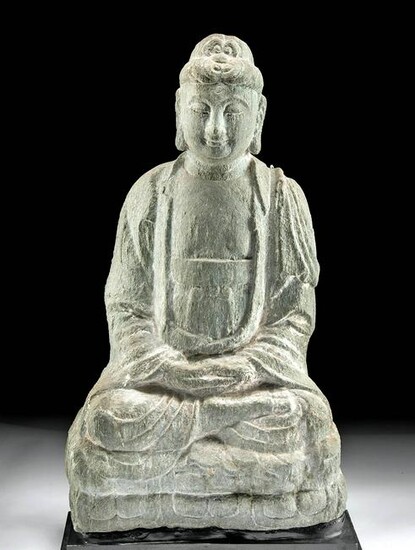Chinese Tang Dynasty Stone Buddha Shakyamuni Statue
East Asia, China, Tang Dynasty, ca. 618 to 907 CE. A finely carved and impressively sizeable, stone Buddha (Shakyamuni, the Enlightened form), traditionally robed and seated in full lotus position atop a double lotus throne pedestal, displaying the dhyana mudra with both hands placed in his lap, palms facing upwards. This gesture of meditation is consonant with his contemplative peaceful visage comprised of downcast eyes, an elegant nose, pursed lips, an urna (circular dot on the forehead) that serves as an auspicious mark symbolizing the third eye which extrapolates to keen vision into the divine world as well as the ability to look past suffering, and characteristically elongated ears - all topped by one of the most elegant topknots we have seen, finely delineated with a symmetrical arrangement of wavy tresses and curls. Size: 14.875" W x 27.75" H (37.8 cm x 70.5 cm); 29.75" H (75.6 cm) on included custom stand.
Buddha's robes are skillfully rendered, draped in a naturalistic way, while his facial features are serene and lifelike. He presents an overall peaceful countenance with the body engaged in meditation and the visage presenting a rounded ushnisha symbolizing the wisdom and knowledge acquired after attaining enlightenment, as well as elongated ears, a physical feature symbolic of the Buddha's time as a prince when he wore elaborate ear ornaments to demonstrate wealth and prosperity. Of course, the prince stopped wearing them when he left the palace to become an ascetic; however, his earlobes remained stretched signifying a conscious decision to reject the material world in exchange for spiritual enlightenment and simultaneously suggest that the Buddha can hear all that is asked for and needed in the earthly world. Those half-closed eyes indicate a meditative state - at once looking both outward and inward. Furthermore, the curled hair of the Buddha signifies the nobility of Buddha. Beyond the multi-layered meaning embodied in the iconography of this piece, the sculptor's artistry and technique are exceptional.
Provenance: private Hawaii USA collection; ex Micky Micklautz collection, Honolulu, Hawaii USA, 1945 to 1990
All items legal to buy/sell under U.S. Statute covering cultural patrimony Code 2600, CHAPTER 14, and are guaranteed to be as described or your money back.
A Certificate of Authenticity will accompany all winning bids.
We ship worldwide to most countries and handle all shipping in-house for your convenience.
#108936
Condition Report: Expected surface wear with some chips to high-pointed areas and areas of abrasion commensurate with age. Scattered deposits grace the surface as well.
View it on
Sale price
Estimate
Time, Location
Auction House
East Asia, China, Tang Dynasty, ca. 618 to 907 CE. A finely carved and impressively sizeable, stone Buddha (Shakyamuni, the Enlightened form), traditionally robed and seated in full lotus position atop a double lotus throne pedestal, displaying the dhyana mudra with both hands placed in his lap, palms facing upwards. This gesture of meditation is consonant with his contemplative peaceful visage comprised of downcast eyes, an elegant nose, pursed lips, an urna (circular dot on the forehead) that serves as an auspicious mark symbolizing the third eye which extrapolates to keen vision into the divine world as well as the ability to look past suffering, and characteristically elongated ears - all topped by one of the most elegant topknots we have seen, finely delineated with a symmetrical arrangement of wavy tresses and curls. Size: 14.875" W x 27.75" H (37.8 cm x 70.5 cm); 29.75" H (75.6 cm) on included custom stand.
Buddha's robes are skillfully rendered, draped in a naturalistic way, while his facial features are serene and lifelike. He presents an overall peaceful countenance with the body engaged in meditation and the visage presenting a rounded ushnisha symbolizing the wisdom and knowledge acquired after attaining enlightenment, as well as elongated ears, a physical feature symbolic of the Buddha's time as a prince when he wore elaborate ear ornaments to demonstrate wealth and prosperity. Of course, the prince stopped wearing them when he left the palace to become an ascetic; however, his earlobes remained stretched signifying a conscious decision to reject the material world in exchange for spiritual enlightenment and simultaneously suggest that the Buddha can hear all that is asked for and needed in the earthly world. Those half-closed eyes indicate a meditative state - at once looking both outward and inward. Furthermore, the curled hair of the Buddha signifies the nobility of Buddha. Beyond the multi-layered meaning embodied in the iconography of this piece, the sculptor's artistry and technique are exceptional.
Provenance: private Hawaii USA collection; ex Micky Micklautz collection, Honolulu, Hawaii USA, 1945 to 1990
All items legal to buy/sell under U.S. Statute covering cultural patrimony Code 2600, CHAPTER 14, and are guaranteed to be as described or your money back.
A Certificate of Authenticity will accompany all winning bids.
We ship worldwide to most countries and handle all shipping in-house for your convenience.
#108936
Condition Report: Expected surface wear with some chips to high-pointed areas and areas of abrasion commensurate with age. Scattered deposits grace the surface as well.



